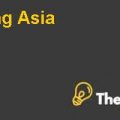
Porter’s Five Forces Model
Threat of a New Entrant
The industry of camera requires huge capital requirements in initiating the business as the industry requires continuous innovation if it needs to stay competitive in the market. Research and Development centers needs to be formed in maintaining competitive edge in the market. However, Polaroid had strong patent rights which made it difficult for other companies to develop a similar product which allows companies to bring their own creation out of the box. In the industry, companies had to maintain economies of scale to reach a particular target revenue. Therefore, the companies only with higher capital could invest to produce products for the mass market. The threat of a new entrant is comparatively low in the industry.
Threat of a Substitute
This aspect of the business is the most overlooked part of the business as companies merely look upon the offering by their competitors but often do not consider the strength of its substitute products while devising strategies. Polaroid had been the company to offer instant camera. However, due to the increased technology many companies including 3M, Sony, Xerox, and others introduces digital camera technology which was far better than the current product as it revolutionized the camera industry. Therefore, the threat of a substitute for the particular industry is high.
Competitive Rivalry
Fuji was the only competitor for Polaroid in the particular industry for instant camera in the international market. In Japan, the company did not have any match for the instant photography category. The intensity of competitive rivalry is moderate as the industry of camera is in the phase of decline due to the slow new product innovation and development. Although there is a presence of very few competitors in the market and with slow competitive environment the particular industry remains moderate.
Bargaining Power of a Supplier
In the particular industry, size matters in determining the bargaining power of a supplier. If there are larger sets of suppliers through which the product is produced then the company would apply reverse auction strategy and might gather the best quoting prices from a supplier. However, if the numbers of suppliers are short then the company would have no choice but to offer the price quoted by the supplier. Therefore, if a company is larger than the suppliers companies then the supplier would negotiate for a better offering, however, if the company’s size is smaller than its suppliers then there would be little power for the company to negotiate.
Bargaining Power of a Buyer
There are a moderate number of buyers and they do not have much substitute available, but they have become loyal to Polaroid and are buying their products because they do not have any other options in the pursuit of buying any better products. In this case, those customers have been described that have the power to reduce the prices at will by looking at the competitive rivalry. This reduces the prices which also lowers the profitability of the company. These customers are found in competitive market which could be found in the similar market where Fuji and Kodak aims to receive a higher market share.
First Priorities for Repositioning Plans
Changing the brand identity in the minds of the company’s stakeholders is the first priority for repositioning of plans for Polaroid. As the market environment opposes Polaroid Corporation in many ways, the environment suggests that the company shall develop new ways in approaching towards its customers. Therefore, focusing on the needs of customers and stick to their behaviors would identify the company with the various challenges it faces in the competition with respect to the product offering and services provided by the company. In order to stabilize the company, it is important to identify the overhead costs which might pose a threat to the company in future. Reducing the costs would provide an opportunity for Polaroid to develop a platform where a company can establish itself for the purpose of generating revenues. Many companies fail to create impression despite of providing good products and services to its customers. However, their costs exceeds to that of revenues which increases the chance of business model failure.
Developing a business model is a key towards attaining profitability by a company. Business Model is referred as the ways by which the company manages its tasks to become profitable and run its business smoothly. Therefore, in order to execute a well-thought plan, the company shall develop a strong business plan which may allow a strong growth and the future competency of the company. Developing a sustainable advantage is also a key towards maintaining a long term profitability as there are very few customers in the market.............................
This is just a sample partial case solution. Please place the order on the website to order your own originally done case solution.












